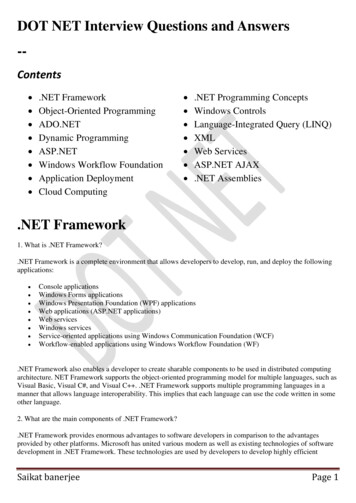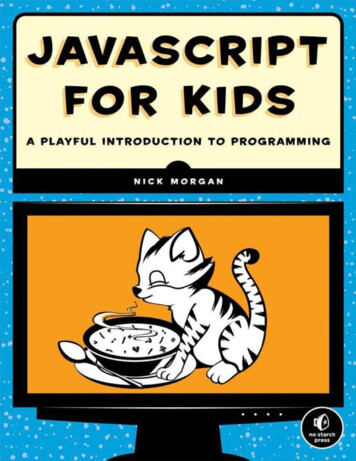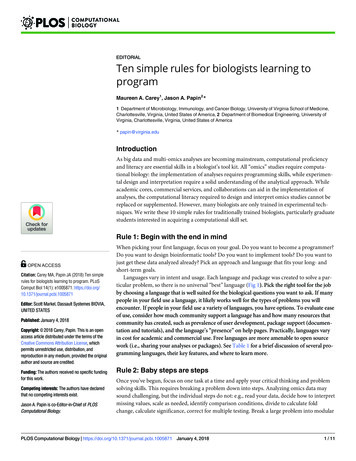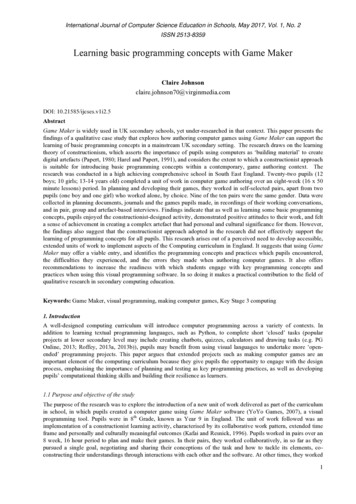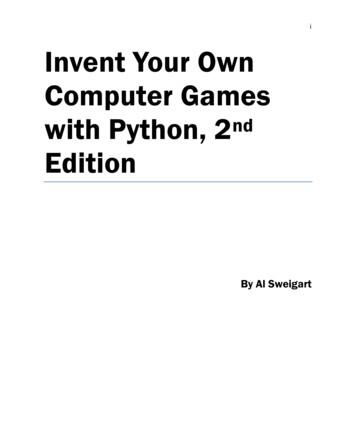
Transcription
linq#linq
Table of ContentsAbout1Chapter 1: Getting started with linq2Remarks2Examples2Setup2The different joins in LINQ2Query Syntax and Method Syntax5LINQ methods, and IEnumerable vs IQueryable6Chapter 2: Linq Using Take while And Skip While9Introduction9Examples9Take method9Skip Method9TakeWhile():9SkipWhile()10Chapter 3: Method execution modes - immediate, deferred streaming, deferred non-streaming 12Examples12Deferred execution vs immediate execution12Streaming mode (lazy evaluation) vs non-streaming mode (eager evaluation)12Benefits of deferred execution - building queries14Benefits of deferred execution - querying current data14Chapter 4: Standard Query Operators16Remarks16Examples16Concatenation Operations16Filtering Operations16Join Operations17Projection Operations19Sorting Operations20Conversion Operations23
Aggregation Operations26Quantifier Operations28Grouping Operations30Partition Operations31Generation Operations32Set Operations34Equality Operations35Element Operations36Credits40
AboutYou can share this PDF with anyone you feel could benefit from it, downloaded the latest versionfrom: linqIt is an unofficial and free linq ebook created for educational purposes. All the content is extractedfrom Stack Overflow Documentation, which is written by many hardworking individuals at StackOverflow. It is neither affiliated with Stack Overflow nor official linq.The content is released under Creative Commons BY-SA, and the list of contributors to eachchapter are provided in the credits section at the end of this book. Images may be copyright oftheir respective owners unless otherwise specified. All trademarks and registered trademarks arethe property of their respective company owners.Use the content presented in this book at your own risk; it is not guaranteed to be correct noraccurate, please send your feedback and corrections to info@zzzprojects.comhttps://riptutorial.com/1
Chapter 1: Getting started with linqRemarksLINQ is a set of features introduced in the .NET Framework version 3.5 that bridges the gapbetween the world of objects and the world of data.Traditionally, queries against data are expressed as simple strings without type checking atcompile time or IntelliSense support. Furthermore, you have to learn a different query language foreach type of data source: SQL databases, XML documents, various Web services, and so on.LINQ makes a query a first-class language construct in C# and Visual Basic. You write queriesagainst strongly typed collections of objects by using language keywords and familiar operators.ExamplesSetupLINQ requires .NET 3.5 or higher (or .NET 2.0 using LINQBridge).Add a reference to System.Core, if it hasn't been added yet.At the top of the file, import the namespace: C#using System;using System.Linq; VB.NETImports System.LinqThe different joins in LINQIn the following examples, we'll be using the following samples:List Product Products new List Product (){new Product(){ProductId 1,Name "Book nr 1",Price 25},new Product(){ProductId 2,Name "Book nr 2",https://riptutorial.com/2
Price 15},new Product(){ProductId 3,Name "Book nr 3",Price 20},};List Order Orders new List Order (){new Order(){OrderId 1,ProductId 1,},new Order(){OrderId 2,ProductId 1,},new Order(){OrderId 3,ProductId 2,},new Order(){OrderId 4,ProductId NULL,},};INNER JOINQuery Syntaxvar joined (from p in Productsjoin o in Orders on p.ProductId equals o.ProductIdselect new{o.OrderId,p.ProductId,p.Name}).ToList();Method Syntaxvar joined Products.Join(Orders, p p.ProductId,o o.OrderId, new{OrderId o.OrderId,ProductId p.ProductId,Name p.Name}).ToList();https://riptutorial.com/3
Result:{ 1, 1, "Book nr 1" },{ 2, 1, "Book nr 1" },{ 3, 2, "Book nr 2" }LEFT OUTER JOINvar joined (from p in Productsjoin o in Orders on p.ProductId equals o.ProductId into gfrom lj in g.DefaultIfEmpty()select new{//For the empty records in lj, OrderId would be NULLOrderId ult:{{{{1, 1,2, 1,3, 2,NULL,"Book nr"Book nr"Book nr3, "Book1"1"2"nr},},},3" }CROSS JOINvar joined (from p in Productsfrom o in Ordersselect :{{{{{1, 1, "Book nr 1"2, 1, "Book nr 1"3, 2, "Book nr 2"NULL, 3, "Book nr4, NULL, NULL }},},},3" },GROUP JOINvar joined (from p in Productsjoin o in Orders on p.ProductId equals o.ProductIdinto tselect new{p.ProductId,p.Name,https://riptutorial.com/4
Orders t}).ToList();The Propertie Orders now contains an IEnumerable Order with all linked Orders.Result:{ 1, "Book nr 1", Orders { 1, 2 } },{ 2, "Book nr 2", Orders { 3 } },{ 3, "Book nr 3", Orders { } },How to join on multiple conditionsWhen joining on a single condition, you can use:join o in Orderson p.ProductId equals o.ProductIdWhen joining on multiple, use:join o in Orderson new { p.ProductId, p.CategoryId } equals new { o.ProductId, o.CategoryId }Make sure that both anonymous objects have the same properties, and in VB.NET, they must bemarked Key, although VB.NET allows multiple Equals clauses separated by And:Join o In OrdersOn p.ProductId Equals o.ProductId And p.CategoryId Equals o.CategoryIdQuery Syntax and Method SyntaxQuery syntax and method syntax are semantically identical, but many people find query syntaxsimpler and easier to read. Let’s say we need to retrieve all even items ordered in ascending orderfrom a collection of numbers.C#:int[] numbers { 0, 1, 2, 3, 4, 5, 6 };// Query syntax:IEnumerable int numQuery1 from num in numberswhere num % 2 0orderby numselect num;// Method syntax:IEnumerable int numQuery2 numbers.Where(num num % 2 0).OrderBy(n n);VB.NET:https://riptutorial.com/5
Dim numbers() As Integer { 0, 1, 2, 3, 4, 5, 6 }' Query syntax: 'Dim numQuery1 From num In numbersWhere num Mod 2 0Select numOrder By num' Method syntax: 'Dim numQuery2 numbers.where(Function(num) num Mod 2 0).OrderBy(Function(num) num)Remember that some queries must be expressed as method calls. For example, you must use amethod call to express a query that retrieves the number of elements that match a specifiedcondition. You also must use a method call for a query that retrieves the element that has themaximum value in a source sequence. So that might be an advantage of using method syntax tomake the code more consistent. However, of course you can always apply the method after aquery syntax call:C#:int maxNum (from num in numberswhere num % 2 0select num).Max();VB.NET:Dim maxNum (From num In numbersWhere num Mod 2 0Select num).Max();LINQ methods, and IEnumerable vs IQueryableLINQ extension methods on IEnumerable T take actual methods1, whether anonymous methods://C#Func int,bool fn x x 3;var list new List int () {1,2,3,4,5,6};var query list.Where(fn);'VB.NETDim fn Function(x As Integer) x 3Dim list New List From {1,2,3,4,5,6};Dim query list.Where(fn);or named methods (methods explicitly defined as part of a class)://C#class Program {bool LessThan4(int x) {return x 4;}https://riptutorial.com/6
void Main() {var list new List int () {1,2,3,4,5,6};var query list.Where(LessThan4);}}'VB.NETClass ProgramFunction LessThan4(x As Integer) As BooleanReturn x 4End FunctionSub MainDim list New List From {1,2,3,4,5,6};Dim query list.Where(AddressOf LessThan4)End SubEnd ClassIn theory, it is possible to parse the method's IL, figure out what the method is trying to do, andapply that method's logic to any underlying data source, not just objects in memory. But parsing ILis not for the faint of heart.Fortunately, .NET provides the IQueryable T interface, and the extension methods atSystem.Linq.Queryable, for this scenario. These extension methods take an expression tree — adata structure representing code — instead of an actual method, which the LINQ provider canthen parse2 and convert to a more appropriate form for querying the underlying data source. Forexample://C#IQueryable Person qry PersonsSet();// Since we're using a variable of type Expression Func Person,bool , the compiler// generates an expression tree representing this codeExpression Func Person,bool expr x x.LastName.StartsWith("A");// The same thing happens when we write the lambda expression directly in the call to// Queryable.Whereqry qry.Where(expr);'VB.NETDim qry As IQueryable(Of Person) PersonSet()' Since we're using a variable of type Expression(Of Func(Of Person,Boolean)), the compiler' generates an expression tree representing this codeDim expr As Expression(Of Func(Of Person, Boolean)) Function(x) x.LastName.StartsWith("A")' The same thing happens when we write the lambda expression directly in the call to' Queryable.Whereqry qry.Where(expr)If (for example) this query is against a SQL database, the provider could convert this expression tothe following SQL statement:SELECT *https://riptutorial.com/7
FROM PersonsWHERE LastName LIKE N'A%'and execute it against the data source.On the other hand, if the query is against a REST API, the provider could convert the sameexpression to an API call:http://www.example.com/person?filtervalue A&filtertype startswith&fieldname lastnameThere are two primary benefits in tailoring a data request based on an expression (as opposed toloading the entire collection into memory and querying locally): The underlying data source can often query more efficiently. For example, there may verywell be an index on LastName. Loading the objects into local memory and querying in-memoryloses that efficiency. The data can be shaped and reduced before it is transferred. In this case, the database /web service only needs to return the matching data, as opposed to the entire set of Personsavailable from the data source.Notes1. Technically, they don't actually take methods, but rather delegate instances which point to methods. However, thisdistinction is irrelevant here.2. This is the reason for errors like "LINQ to Entities does not recognize the method 'System.String ToString()' method,and this method cannot be translated into a store expression.". The LINQ provider (in this case the Entity Frameworkprovider) doesn't know how to parse and translate a call to ToString to equivalent SQL.Read Getting started with linq online: rted-with-linqhttps://riptutorial.com/8
Chapter 2: Linq Using Take while And SkipWhileIntroductionTake, Skip, TakeWhile and SkipWhile are all called Partitioning Operators since they obtain asection of an input sequence as determined by a given condition. Let us discuss these operatorsExamplesTake methodThe Take Method Takes elements up to a specified position starting from the first element in asequence. Signature of Take:Public static IEnumerable TSource Take TSource (this IEnumerable TSource source,int count);Example:int[] numbers { 1, 5, 8, 4, 9, 3, 6, 7, 2, 0 };var TakeFirstFiveElement numbers.Take(5);Output:The Result is 1,5,8,4 and 9 To Get Five Element.Skip MethodSkips elements up to a specified position starting from the first element in a sequence.Signature of Skip:Public static IEnumerable Skip(this IEnumerable source,int count);Exampleint[] numbers { 1, 5, 8, 4, 9, 3, 6, 7, 2, 0 };var SkipFirstFiveElement numbers.Take(5);Output: The Result is 3,6,7,2 and 0 To Get The Element.TakeWhile():Returns elements from the given collection until the specified condition is true. If the first elementhttps://riptutorial.com/9
itself doesn't satisfy the condition then returns an empty collection.Signature of TakeWhile():Public static IEnumerable TSource TakeWhile TSource (this IEnumerable TSource source,Func TSource,bool ,predicate);Another Over Load Signature:Public static IEnumerable TSource TakeWhile TSource (this IEnumerable TSource source,Func TSource,int,bool ,predicate);Example I:int[] numbers { 1, 5, 8, 4, 9, 3, 6, 7, 2, 0 };var SkipFirstFiveElement numbers.TakeWhile(n n 9);Output:It Will return Of eleament 1,5,8 and 4Example II :int[] numbers { 1, 2, 3, 4, 9, 3, 6, 7, 2, 0 };var SkipFirstFiveElement numbers.TakeWhile((n,Index) n index);Output:It Will return Of element 1,2,3 and 4SkipWhile()Skips elements based on a condition until an element does not satisfy the condition. If the firstelement itself doesn't satisfy the condition, it then skips 0 elements and returns all the elements inthe sequence.Signature of SkipWhile():Public static IEnumerable TSource SkipWhile TSource (this IEnumerable TSource source,Func TSource,bool ,predicate);Another Over Load Signature:Public static IEnumerable TSource SkipWhile TSource (this IEnumerable TSource source,Func TSource,int,bool ,predicate);Example I:int[] numbers { 1, 5, 8, 4, 9, 3, 6, 7, 2, 0 };https://riptutorial.com/10
var SkipFirstFiveElement numbers.SkipWhile(n n 9);Output:It Will return Of element 9,3,6,7,2 and 0.Example II:int[] numbers { 4, 5, 8, 1, 9, 3, 6, 7, 2, 0 };var indexed numbers.SkipWhile((n, index) n index);Output:It Will return Of element 1,9,3,6,7,2 and 0.Read Linq Using Take while And Skip While online: /11
Chapter 3: Method execution modes immediate, deferred streaming, deferred nonstreamingExamplesDeferred execution vs immediate executionSome LINQ methods return a query object. This object does not hold the results of the query;instead, it has all the information needed to generate those results:var list new List int () {1, 2, 3, 4, 5};var query list.Select(x {Console.Write( "{x} ");return x;});The query contains a call to Console.Write, but nothing has been output to the console. This isbecause the query hasn't been executed yet, and thus the function passed to Select has neverbeen evaluated. This is known as deferred execution -- the query's execution is delayed untilsome later point.Other LINQ methods force an immediate execution of the query; these methods execute thequery and generate its values:var newList query.ToList();At this point, the function passed into Select will be evaluated for each value in the original list, andthe following will be output to the console:12345Generally, LINQ methods which return a single value (such as Max or Count), or which return anobject that actually holds the values (such as ToList or ToDictionary) execute immediately.Methods which return an IEnumerable T or IQueryable T are returning the query object, and allowdeferring the execution until a later point.Whether a particular LINQ method forces a query to execute immediately or not, can be found atMSDN -- C#, or VB.NET.Streaming mode (lazy evaluation) vs non-streaming mode (eager evaluation)Of the LINQ methods which use deferred execution, some require a single value to be evaluatedhttps://riptutorial.com/12
at a time. The following code:var lst new List int () {3, 5, 1, 2};var streamingQuery lst.Select(x {Console.WriteLine(x);return x;});foreach (var i in streamingQuery) {Console.WriteLine( "foreach iteration value: {i}");}will output:3foreach iteration value: 35foreach iteration value: 51foreach iteration value: 12foreach iteration value: 2because the function passed to Select is evaluated at each iteration of the foreach. This is knownas streaming mode or lazy evaluation.Other LINQ methods -- sorting and grouping operators -- require all the values to be evaluated,before they can return any value:var nonStreamingQuery lst.OrderBy(x {Console.WriteLine(x);return x;});foreach (var i in nonStreamingQuery) {Console.WriteLine( "foreach iteration value: {i}");}will output:3512foreach iteration value: 1foreach iteration value: 2foreach iteration value: 3foreach iteration value: 5In this case, because the values must be generated to the foreach in ascending order, all theelements must first be evaluated, in order to determine which is the smallest, and which is the nextsmallest, and so on. This is known as non-streaming mode or eager evaluation.https://riptutorial.com/13
Whether a particular LINQ method uses streaming or non-streaming mode, can be found at MSDN-- C#, or VB.NET.Benefits of deferred execution - building queriesDeferred execution enables combining different operations to build the final query, beforeevaluating the values:var list new List int () {1,1,2,3,5,8};var query list.Select(x x 1);If we execute the query at this point:foreach (var x in query) {Console.Write( "{x} ");}we would get the following output:223469But we can modify the query by adding more operators:Console.WriteLine();query query.Where(x x % 2 0);query query.Select(x x * 10);foreach (var x in query) {Console.Write( "{x} ");}Output:20 20 40 60Benefits of deferred execution - querying current dataWith deferred execution, if the data to be queried is changed, the query object uses the data at thetime of execution, not at the time of definition.var data new List int () {2, 4, 6, 8};var query data.Select(x x * x);If we execute the query at this point with an immediate method or foreach, the query will operateon the list of even numbers.However, if we change the values in the list:data.Clear();data.AddRange(new [] {1, 3, 5, 7, 9});https://riptutorial.com/14
or even if we assign a a new list to data:data new List int () {1, 3, 5, 7, 9};and then execute the query, the query will operate on the new value of data:foreach (var x in query) {Console.Write( "{x} ");}and will output the following:1 9 25 49 81Read Method execution modes - immediate, deferred streaming, deferred non-streaming g-deferred-non-streaminghttps://riptutorial.com/15
Chapter 4: Standard Query OperatorsRemarksLinq queries are written using the Standard Query Operators (which are a set of extensionmethods that operates mainly on objects of type IEnumerable T and IQueryable T ) or using QueryExpressions (which at compile time, are converted to Standard Query Operator method calls).Query operators provide query capabilities including filtering, projection, aggregation, sorting andmore.ExamplesConcatenation OperationsConcatenation refers to the operation of appending one sequence to another.ConcatConcatenates two sequences to form one sequence.Method Syntax// Concatvar numbers1 new int[] { 1, 2, 3 };var numbers2 new int[] { 4, 5, 6 };var numbers numbers1.Concat(numbers2);// numbers { 1, 2, 3, 4, 5, 6 }Query Syntax// Not applicable.Filtering OperationsFiltering refers to the operations of restricting the result set to contain only those elements thatsatisfy a specified condition.WhereSelects values that are based on a predicate function.Method Syntaxhttps://riptutorial.com/16
// Wherevar numbers new int[] { 1, 2, 3, 4, 5, 6, 7, 8 };var evens numbers.Where(n n % 2 0);// evens { 2, 4, 6, 8 }Query Syntax// wherevar numbers new int[] { 1, 2, 3, 4, 5, 6, 7, 8 };var odds from n in numberswhere n % 2 ! 0select n;// odds { 1, 3, 5, 7 }OfTypeSelects values, depending on their ability to be cast to a specified type.Method Syntax// OfTypevar numbers new object[] { 1, "one", 2, "two", 3, "three" };var strings numbers.OfType string ();// strings { "one", "two", "three" }Query Syntax// Not applicable.Join OperationsA join of two data sources is the association of objects in one data source with objects that share acommon attribute in another data source.JoinJoins two sequences based on key selector functions and extracts pairs of values.Method Syntax// Joinclass Customerhttps://riptutorial.com/17
{public int Id { get; set; }public string Name { get; set; }}class Order{public string Description { get; set; }public int CustomerId { get; set; }}.var customers new Customer[]{new Customer { Id 1, Name "C1" },new Customer { Id 2, Name "C2" },new Customer { Id 3, Name "C3" }};var orders new Order[]{new Order { Descriptionnew Order { Descriptionnew Order { Descriptionnew Order { Description}; CustomerId 1123},},},},var join customers.Join(orders, c c.Id, o o.CustomerId, (c, o) c.Name "-" o.Description);// join { "C1-O1", "C1-O2", "C2-O3", "C3-O4" }Query Syntax// join in on equals var join from c in customersjoin o in orderson c.Id equals o.CustomerIdselect o.Description "-" c.Name;// join { "O1-C1", "O2-C1", "O3-C2", "O4-C3" }GroupJoinJoins two sequences based on key selector functions and groups the resultingmatches for each element.Method Syntax// GroupJoinvar groupJoin customers.GroupJoin(orders,c c.Id,o o.CustomerId,(c, ors) c.Name "-" string.Join(",", ors.Select(o o.Description)));https://riptutorial.com/18
// groupJoin { "C1-O1,O2", "C2-O3", "C3-O4" }Query Syntax// join in on equals into var groupJoin from c in customersjoin o in orderson c.Id equals o.CustomerIdinto customerOrdersselect string.Join(",", customerOrders.Select(o o.Description)) "-" c.Name;// groupJoin { "O1,O2-C1", "O3-C2", "O4-C3" }ZipApplies a specified function to the corresponding elements of two sequences,producing a sequence of the results.var numbers new [] { 1, 2, 3, 4, 5, 6 };var words new [] { "one", "two", "three" };var numbersWithWords numbers.Zip(words,(number, word) new { number, word });// Results// // // // // number-----123 word ----- one two three Projection OperationsProjection refers to the operations of transforming an object into a new form.SelectProjects values that are based on a transform function.Method Syntax// Selectvar numbers new int[] { 1, 2, 3, 4, 5 };var strings numbers.Select(n n.ToString());// strings { "1", "2", "3", "4", "5" }https://riptutorial.com/19
Query Syntax// selectvar numbers new int[] { 1, 2, 3, 4, 5 };var strings from n in numbersselect n.ToString();// strings { "1", "2", "3", "4", "5" }SelectManyProjects sequences of values that are based on a transform function and then flattensthem into one sequence.Method Syntax// SelectManyclass Customer{public Order[] Orders { get; set; }}class Order{public Order(string desc) { Description desc; }public string Description { get; set; }}.var customers new Customer[]{new Customer { Orders new Order[] { new Order("O1"), new Order("O2") } },new Customer { Orders new Order[] { new Order("O3") } },new Customer { Orders new Order[] { new Order("O4") } },};var orders customers.SelectMany(c c.Orders);// orders { Order("O1"), Order("O3"), Order("O3"), Order("O4") }Query Syntax// multiples fromvar orders from c in customersfrom o in c.Ordersselect o;// orders { Order("O1"), Order("O3"), Order("O3"), Order("O4") }Sorting Operationshttps://riptutorial.com/20
A sorting operation orders the elements of a sequence based on one or more attributes.OrderBySorts values in ascending order.Method Syntax// OrderByvar numbers new int[] { 5, 4, 8, 2, 7, 1, 9, 3, 6 };var ordered numbers.OrderBy(n n);// ordered { 1, 2, 3, 4, 5, 6, 7, 8, 9 }Query Syntax// orderbyvar numbers new int[] { 5, 4, 8, 2, 7, 1, 9, 3, 6 };var ordered from n in numbersorderby nselect n;// ordered { 1, 2, 3, 4, 5, 6, 7, 8, 9 }OrderByDescendingSorts values in descending order.Method Syntax// OrderByDescendingvar numbers new int[] { 5, 4, 8, 2, 7, 1, 9, 3, 6 };var ordered numbers.OrderByDescending(n n);// ordered { 9, 8, 7, 6, 5, 4, 3, 2, 1 }Query Syntax// orderbyvar numbers new int[] { 5, 4, 8, 2, 7, 1, 9, 3, 6 };var ordered from n in numbersorderby n descendingselect n;// ordered { 9, 8, 7, 6, 5, 4, 3, 2, 1 }https://riptutorial.com/21
ThenByPerforms a secondary sort in ascending order.Method Syntax// ThenBystring[] words { "the", "quick", "brown", "fox", "jumps" };var ordered words.OrderBy(w w.Length).ThenBy(w w[0]);// ordered { "fox", "the", "brown", "jumps", "quick" }Query Syntax// orderby , string[] words { "the", "quick", "brown", "fox", "jumps" };var ordered from w in wordsorderby w.Length, w[0]select w;// ordered { "fox", "the", "brown", "jumps", "quick" }ThenByDescendingPerforms a secondary sort in descending order.Method Syntax// ThenByDescendingstring[] words { "the", "quick", "brown", "fox", "jumps" };var ordered words.OrderBy(w w[0]).ThenByDescending(w w.Length);// ordered { "brown", "fox", "jumps", "quick", "the" }Query Syntax// orderby , descendingstring[] words { "the", "quick", "brown", "fox", "jumps" };var ordered from w in wordsorderby w.Length, w[0] descendingselect w;// ordered { "the", "fox", "quick", "jumps", "brown" }Reversehttps://riptutorial.com/22
Reverses the order of the elements in a collection.Method Syntax// Reversevar numbers new int[] { 1, 2, 3, 4, 5 };var reversed numbers.Reverse();// reversed { 5, 4, 3, 2, 1 }Query Syntax// Not applicable.Conversion OperationsConversion operations change the type of input objects.AsEnumerableReturns the input typed as IEnumerable.Method Syntax// AsEnumerableint[] numbers { 1, 2, 3, 4, 5 };var nums numbers.AsEnumerable();// nums: static type is IEnumerable int Query Syntax// Not applicable.AsQueryableConverts a IEnumerable to a IQueryable.Method Syntax// AsQueryableint[] numbers { 1, 2, 3, 4, 5 };var nums numbers.AsQueryable();// nums: static type is IQueryable int https://riptutorial.com/23
Query Syntax// Not applicable.CastCasts the elements of a collection to a specified type.Method Syntax// Castvar numbers new object[] { 1, 2, 3, 4, 5 };var nums numbers.Cast int ();// nums: static type is IEnumerable int Query Syntax// Use an explicitly typed range variable.var numbers new object[] { 1, 2, 3, 4, 5 };var nums from int n in numbers select n;// nums: static type is IEnumerable int OfTypeFilters values, depending on their ability to be cast to a specified type.Method Syntax// OfTypevar objects new object[] { 1, "one", 2, "two", 3, "three" };var numbers objects.OfType int ();// nums { 1, 2, 3 }Query Syntax// Not applicable.ToArrayConverts a collection to an array.https://riptutorial.com/24
Method Syntax// ToArrayvar numbers Enumerable.Range(1, 5);int[] array numbers.ToArray();// array { 1, 2, 3, 4, 5 }Query Syntax// Not applicable.ToListConverts a collection to a list.Method Syntax// ToListvar numbers Enumerable.Range(1, 5);List int list numbers.ToList();// list { 1, 2, 3, 4, 5 }Query Syntax// Not applicable.ToDictionaryPuts elements into a dictionary based on a key selector function.Method Syntax// ToDictionaryvar numbers new int[] { 1, 2, 3 };var dict numbers.ToDictionary(n n.ToString());// dict { "1" 1, "2" 2, "3" 3 }Query Syntax// Not applicable.https://riptutorial.com/25
Aggregation OperationsAggregation operations computes a single value from a collection of values.AggregatePerforms a custom aggregation operation on the values of a collection.Method Syntax// Aggregatevar numbers new int[] { 1, 2, 3, 4, 5 };var product numbers.Aggregate(1, (acc, n) acc * n);// product 120Query Syntax// Not applicable.AverageCalculates the average value of a collection of values.Method Syntax// Averagevar numbers new int[] { 1, 2, 3, 4, 5 };var average numbers.Average();// average 3Query Syntax// Not applicable.CountCounts the elements in a collection, optionally only those elements that satisfy apredicate function.Method Syntax// Countvar numbers new int[] { 1, 2, 3, 4, 5 };https://riptutorial.com/26
int count numbers.Count(n n % 2 0);// count 2Query Syntax// Not applicable.LongCountCounts the elements in a large collection, optionally only those elements that satisfy apredicate function.Method Syntax// LongCountvar numbers new int[] { 1, 2, 3, 4, 5, 6, 7, 8, 9, 10 };long count numbers.LongCount();// count 10Query Syntax// Not applicable.MaxDetermines the maximum value in a collection. Throws exception if collection is empty.Method Syntax// Maxvar numbers new int[] { 1, 2, 3, 4, 5 };var max numbers.Max();// max 5Query Syntax// Not applicable.MinDetermines the minimum value in a collection. Throws exception if collection is empty.https://riptutorial.com/27
Method Syntax// Minvar numbers new int[] { 1, 2, 3, 4, 5 };var min numbers.Min();// min 1Query Syntax// Not applicable.Min-/MaxOrDefaultUnlike other LinQ extensions Min() and Max() do not have an overload withoutexceptions. Therefor the IEnumerable must be checked for Any() before calling Min() orMax()// Maxvar numbers new int[] { };var max numbers.Any() ? numbers.Max() : 0;// max 0SumCalculates the sum of the values in a collection.Method Syntax// Sumvar numbers new int[] { 1, 2, 3, 4, 5 };var sum numbers.Sum();// sum 15Query Syntax// Not applicable.Quantifier OperationsQuantifier operations return a Boolean value that indicates whether some or all of the elements ina sequence satisfy a condition.https://riptutorial.com/28
AllDetermines whether all the elements in a sequence satisfy a condition.Method Syntax// Allvar numbers new int[] { 1, 2, 3, 4, 5 };bool areLessThan10 numbers.All(n n 10);// areLessThan10 trueQuery Syntax// Not applicable.AnyDetermines whether any elements in a sequence satisfy a condition.Method Syntax// Anyvar numbers new int[] { 1, 2, 3, 4, 5 };bool anyOneIsEven numbers.Any(n n % 2 0);// anyOneIsEven trueQuery Syntax// Not applicable.ContainsDetermines whether a sequence contains a specified element.Method Syntax// Containsvar numbers new int[] { 1, 2, 3, 4, 5 };bool appears numbers.Contains(10);// appears falseQuery Syntaxhttps://riptutorial.com/29
// Not applicable.Grouping OperationsGrouping refers to the operations of putting data into groups so that the elements in each groupshare a common attribute.GroupByGroups elements that share a common attribute.Method Syntax// GroupByclass Order{public string Custo
Chapter 1: Getting started with linq Remarks LINQ is a set of features introduced in the .NET Framework version 3.5 that bridges th

